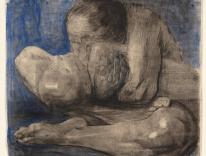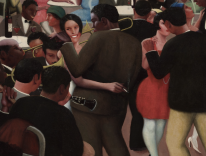“The Sacred Made Real,” the National Gallery of Art’s exhibit on seventeenth-century Spanish painting and sculpture, is a quick but intense experience. Only twenty-two pieces are on display until May 31, gathered from museums and religious institutions across Spain, including the Prado, as well as American and British collections. Paintings and painted sculptures are paired to show how artists collaborated to create a new bloody-minded and realistic sacred art.
The museum has chosen to highlight that technical aspect of the artworks. There’s a short film accompanying the exhibit which shows exactly how artists in different media worked together to create painted statues. But even a technical approach can’t distract from the raw spiritual impact of the artworks themselves, many of which ordinarily reside in a “working” church or monastery. The nicknames given to two of these pieces by the faithful—the “Christ of Love” and the “Christ of the Helpless”—should indicate their purpose. These pieces weren’t designed just to be admired but to be used. The sculpture that opens the exhibit is still carried through the streets of Seville on Palm Sunday.
Even in a museum, with captions on the walls and the appreciative hush of tourists rather than the susurrus of rosaries, the paintings and sculptures still have their desired effect. Visitors walk out of the National Gallery’s bright, glassy expanses into the dark, quiet rooms of the exhibit as if they’re stepping into a grotto or a cell. The exhibit opens with three works that exemplify its themes: a sculpture of Christ on the Cross by Juan de Mesa, a Diego Velázquez portrait of the sculptor Juan Martínez Montañés, and a Francisco de Zurbarán painting of St. Luke contemplating the Crucifixion.
You can count the ribs on de Mesa’s Christ. His knees are bloodied and his muscles tensed with pain. Spanish crucifixes are known for Mel Gibson levels of gore, and while de Mesa’s work (the “Christ of Love”) is not as extreme as some of the others in this exhibit, it’s still a visceral rather than serene portrayal—all the more visceral, and all the more distressing, for having been painted. De Zurbarán’s St. Luke holds a painter’s palette and gazes at a drained, gray Christ. The painting’s intense contrasts of darkness and brightness are as typically Spanish as the emphasis on Christ’s physical suffering. Finally, the Velázquez painting is included to illustrate how closely painters and sculptors worked together in this era. Although outside Spain the painters are much better known than the sculptors, this exhibit makes the case that both kinds of artists must be considered together.
To that end the exhibit gives us paintings and sculptures that mirror one another, taking on the same subject matter with similar styles and emphases. A de Zurbarán painting of St. Francis of Assisi standing in ecstasy shows a young and hopeful saint. A more cadaverous and stricken version of the same image is sculpted by Pedro de Mena, with rough patchwork robes rather than the painted saint’s smooth, pale gray habit.
In all these images the emphasis is on individuality: expressive features and gestures rather than stylized iconography. Velázquez’s Virgin is a chipmunk-cheeked girl, while Mary in a Pietà by an unknown sculptor throws her hand out as if to ward off jeering spectators. One of the several functions of the saints is to give us models of holiness to which we can relate in our everyday lives: there are patron saints of police officers, boxers, pub owners, even journalists. The Spanish style works similarly to give saints and sacred scenes a feeling of immediacy. If it’s shocking to learn that anyone was martyred, it’s more shocking to learn that a martyr lived next door to you.
There’s also a recurring theme of contemplation in the exhibit. Saints contemplate the crucified Christ, and Christ in turn gazes on them. There’s an achingly tender painting by Francisco Ribalta in which Christ embraces St. Bernard of Clairvaux. The kneeling mystic, wrinkled and veiny, rests against Christ with an expression of rapturous relief. Many other artworks show penitent saints contemplating skulls or crucifixes. The images are meant not only to inspire but to instruct: the viewer is invited to imitate what he sees the saints doing.
This Spanish style is sometimes called “realism,” and the National Gallery’s exhibit title reflects that assessment. The sculptures incorporate real linen and even real human hair. The individualized facial expressions and poses (and, for that matter, the emphasis on individual artists: the exhibit notes that Juan Martínez Montañés was called “the god of wood,” as if he were himself an idol) offer sharp contrasts to the much more stylized depictions found in, for example, icons of the Eastern churches. Precisely in their abstraction from our everyday experience, icons appear to transcend that experience. They offer a vision of God and the saints as something apart. Contrasted to these images the Spanish style must seem as quotidian as the line of dead ducks hanging in a Chinese butcher’s window.
But, like the lighting in one of these Spanish paintings, the term “realism” can obscure as much as it illuminates. It might suggest that these works are about a direct representation of religious experience unmediated by artistic choices and stylization. In fact, as the National Gallery’s show makes plain, the Spanish artists use naturalistic details as part of a symbolic alphabet that goes beyond the ordinarily visible world. The dramatic, almost noir lighting of many Spanish paintings isn’t exactly naturalistic; it doesn’t tell us how the window was placed in St. Francis’s monastery. The lighting is instead a representation of a heightened emotional and spiritual state. These works often capture the liminal states of ecstasy or dying. Like their subjects, they straddle the threshold between the ordinary experiences of this life and the electric moment of contact with God.
The final room of the exhibit shows only three artworks, all depictions of the Passion. And yet these three images, each overwhelming in its way, highlight the different choices artists can make in emphasizing one aspect or another of Christ’s life. Gregorio Fernández’s Ecce Homo is like a sculpted Greek youth, with relatively broad thighs and grimy feet. He holds his hands up toward his chest, covering himself, unlike the exposed Christs on the cross that stand near him. Juan Martínez Montañés sculpted a very different Christ, known as the “Christ of the Helpless,” an already dead and brutally emaciated figure. And de Zurbarán contributes a second crucifixion, a painting with the glowing whites and heavy darknesses that make him one of the most striking and luridly spiritual painters of the era.
In only a few fairly small rooms, “The Sacred Made Real” takes us through extremes of horror and ecstasy. The works presented here attempt to tear away the veil of ordinary reality, so that something extraordinary yet no less real can penetrate.
Please email comments to [email protected] and join the conversation on our Facebook page.
Previous Story
Thinking Again
Next Story
Off the Page


